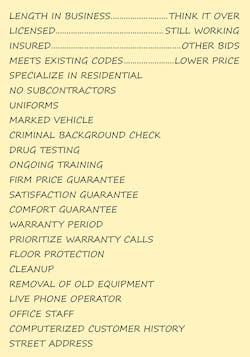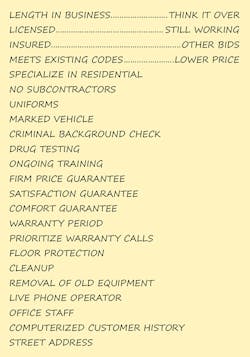The 'List of Talking Points' Close
Let’s say that after a few closing attempts, they tell you they’re 90% certain they’re going to go with you, but they want to sleep on it or talk get a another bid or two. Now what?
A good salesman never meets an objection head-on. Remember, a good closer doesn’t “sell” per se, but merely helps people make the right decision, so be a good sport about things and give them a hand with this.
Say, “Of course you do. Have you ever bought one of these before?” Whether they reply with a yes or a no makes no difference. Just continue on with, "Have you ever heard of people being unhappy with a home improvement contractor? Maybe they didn’t get exactly what they wanted, felt they’d been hit with hidden charges, or the contractor sent out a bunch of people they’re not comfortable with working in their home?” Again, whether they respond with a yes or a no makes no difference.
Say, "Sometimes the 'lowest bidder' actually ends up being the highest bidder with little hidden charges, like permit fees, disposal fees, recovery charges, disposal charges, sales tax, cleaning fees, etc.
Do not print this list out and try to read it off to customers! They'll just take it out of your hands and thank you for it. You won't get a chance to close.
"I believe that, while some of these situations may be a result of malicious intentions on the part of the contractor, most of them are more a result of miscommunication than anything else. The customer may have a picture in mind as to what a complete installation entails and one set of expectations, while the contractor had an entirely different picture in mind as to what the installation entailed.
"Do you know what points to bring up; what questions to ask contractors to make certain you’re both on the same wavelength and avoid the disappointments that others have experienced?
Take out a blank sheet of lined paper and say, "Tell you what, why don’t I go ahead and draw up a short list of ‘talking points’ for you to go over with the other people you talk to, to make certain you have a complete understanding, so you won’t be disappointed with the installation experience or final product?"
Assuming you’ve established your own person credibility and rapport with the customer and haven’t overstayed your welcome, they’ll answer in the affirmative, but don't wait for a response, just start your list.
The List
Say, "Find out how long they've been in business. You want someone who knows the codes, the climate, and the construction in this area, and that they're going to remain in business for at least the length of your warranty", and write "length in business at the top of the page. (See Figure 1)
Say, “Make certain they’re licensed,” and explain the benefits of doing business with a licensed contractor. Write “licensed” on the paper.
Go on to say, “Make certain they’re insured,” and explain the absolute importance of doing business with a company that is fully insured. Write “insured” on the paper.
Say, “Make sure that removing the old equipment is included in their price and that you get that in writing on their work order.” Write “removal of old equipment” on the paper.
Continue going over your “features and benefits” list, writing an abbreviated form of each feature and/or benefit down on the sheet of paper, using the left hand margin, until you’ve listed twenty-five talking points. See the illustration for inspiration.
The Final Summary
Summarize by asking, “Mr. Smith, is this a list of things that contractors will have to do in order to earn the right to your business?”
They tend to take the high road and say, “Yes.”
“So, there’s nothing on this list that is ‘extra,’ overkill or anything that you don’t want?”
The customer will say, “No.”
Continue with, “So, a person will have to be willing to put all these things in writing in order to earn the right to your business?”
The customer will say, “Yes. They’ll have to do all of that in order to earn the right to my business”
Take a pause, then continue, “Well, I agree. You know, we’ve been in business for many years, and this is a list of things our customers have told us they demand from a contractor in order to earn the right to their business.
“We’ve patterned our entire operation on what our customers have told us they want us to provide them with. You might actually say that this is a list of reasons for me to take care of this for you right now.
“For the fun of it, let’s just make a little list of reasons not to just go ahead with this right now.”
At this point, you’ll start another list at the top of the page, using the center line of the page as your left margin.
Say, “You usually like to think things over,” and write “Think it over” at the top of the list.
When it applies, you can also add, “Your equipment is still running,” and add “Still running,” to the list.
Go on to say, “You want to get other bids,” and write “Other bids” on the list.
Continue with, “I imagine your reason to get other prices is you hope to be able to find the exact same thing that I’m going to provide you with for a lower price, right?”
He’ll answer, “Yes,” and you’ll write, “Lower price,” on your list.
Don’t leave any reasons “not to go ahead now” up to the customer. Come up with them yourself. You want to take the wind out of his sails!
Now ask the customer, “Mr. Smith, is there any other reason you wouldn’t want to go ahead with this?”
Naturally, we already know he'll have to say, "No," because you’ve already listed all the reasons to wait.
Explain, “Mr. Smith, as I mentioned previously, my company has been in business for many years and done hundreds (maybe thousands; try to be reasonably accurate) of installations.
“The vast majority of those people got other prices and decided to go with us, despite any difference in price.
“And the reason they decided to use us is they found out what you’re going to find out when you go over this list with my competition. You can’t get all these benefits in writing from any of them for any price, even a higher price, let alone a lower price.
"Now, if you want to spend two, eight, twelve, twenty or forty hours to learn the same thing that thousands of other people already know, don’t let me stand in your way. I want your decision to go with me and my company to be your decision and not my decision and if that’s what it takes for you to realize that my offer is really your only option, by all means, you do what you have to do.
“But, if you’re looking to save yourself a little time, you can make the same decision that our thousands of customers have already made and schedule this now.”
I hold the list up by the upper right hand corner so that the left side of the paper kind of leans downward a little, and say, “Mr. Smith, this is a list of reasons to have me go ahead and take care of this for you right now. This is a list of reasons to hold off. Which side weighs more heavily to you?”
Naturally, he’ll respond with, “The left side, of course.”
Say, “Mr. Smith, I believe you’ve made your decision. Would you like me to call the office and schedule this installation for you?”
A Word of Caution
Anyone who is familiar with my work knows that I am constantly stressing the importance of salespeople knowing why people should buy from them and being able to articulate those reasons. The fact that most salespeople are too lazy to put that kind of effort into mastering their profession is exactly why you want to do it. When people get other bids, the other salespeople won't be able to tell them why they should buy from them.
You have to memorize your list and write it up for each individual customer. If you need a neat, pre-printed list because you don't have good handwriting, you still write the list by hand with each customer and try to close them. If you are unable to close them, then you can hand them the pre-printed list before you leave.
You might recognize this technique as a modified version of the old, "Ben Franklin Close". The differences are that I have customized it for HVAC replacements, and the introduction. Don't use the old introduction. Use this one. It's way better.
This is my favorite close. This article also happens to mark 15 years and one month of my contributing a monthly column in this publication. Adding the 20 articles I randomly contributed over several years prior to becoming a regular columnist equals exactly 200 columns. I can't believe it's taken me this long to share this technique with you.
Charlie Greer is an award-winning salesman and sales trainer. The complete dialogue for this closing technique is included in his audio book "Slacker's Guide to HVAC Sales". For more information on Charlie's products and services, go to www.hvacprofitboosters.com or call 1-800-963-HVAC (4822). Email your sales questions to [email protected].

